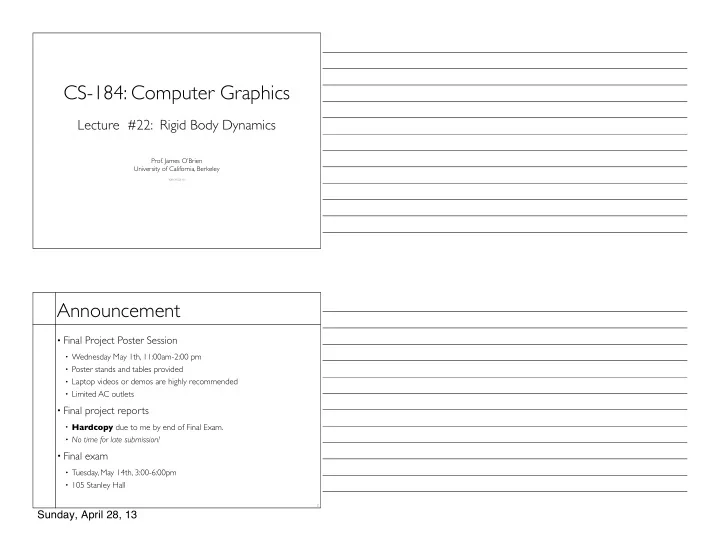

CS-184: Computer Graphics Lecture #22: Rigid Body Dynamics Prof. James O’Brien University of California, Berkeley V2013-S-22-1.0 Announcement • Final Project Poster Session • Wednesday May 1th, 11:00am-2:00 pm • Poster stands and tables provided • Laptop videos or demos are highly recommended • Limited AC outlets • Final project reports • Hardcopy due to me by end of Final Exam. • No time for late submission! • Final exam • Tuesday, May 14th, 3:00-6:00pm • 105 Stanley Hall 2 Sunday, April 28, 13
Today • Rigid-body dynamics • Articulated systems 3 A Rigid Body A solid object that does not deform Consists of infinite number of infinitesimal mass points... ...that share a single RB transformation Rotation + Translation (no shear or scale) x W = R · x L + t Rotation and translation vary over time Limit of deformable object as ks → ∞ 4 3 Sunday, April 28, 13
A Rigid Body In 2D: Translation 2 “directions” Center of mass Rotation 1 “direction” 3 DOF Total In 3D: Translation 3 “directions” Rotation 3 “direction” 6 DOF Total Translation and rotation are decoupled 2D is boring... we’ll stick to 3D from now on... 5 Translational Motion Just like a point mass: v p = v ˙ v = a = f /m ˙ Note: Recall discussion on integration... 6 Sunday, April 28, 13
Rotational Motion Rotation gets a bit odd, as well see... ω Rotational “position” R v Rotation matrix Exponential map Quaternions ω Rotational velocity Stored as a vector (Also called angular velocity...) Measured in radians / second 7 Rotational Motion Kinetic energy due to rotation: ω “Sum energy (from rotation) over v all points in the object” Z 1 E = 2 ρ ˙ x · ˙ x du Ω Z 1 E = 2 ρ ([ ω × ] x ) · ([ ω × ] x ) du Ω 8 Sunday, April 28, 13
Rotational Motion Angular momentum H Similar to linear momentum ω Can be derived from rotational energy v Z H = ρ x × ˙ x du Figure is a lie if this Ω really is a sphere... Z H = ρ x × ( ω × x ) du Ω ✓Z ◆ H = · · · du ω Ω “Inertia Tensor” not H = I ω identity matrix... 9 Inertia Tensor y 2 + z 2 − xy − xz Z z 2 + x 2 I = − xy − yz d u Ω ρ x 2 + y 2 − xz − yz See example for simple shapes at http://scienceworld.wolfram.com/physics/MomentofInertia.html Can also be computed from polygon models by transforming volume integral to a surface one. See paper/code by Brian Mirtich. 10 Sunday, April 28, 13
Rotational Motion H Conservation or momentum: ω H W = I W ω W v H W = RI L R T ω W W = ˙ RI L R T ω W + RI L ˙ T ω W + RI L R T α W Figure is a lie if this really is a sphere... ˙ H R H W = 0 ˙ α W = ( RI L R T ) − 1 ( − ω W × H W ) ˙ R = ω × R In other words, things wobble when they rotate. 11 Rotational Motion H ˙ R = [ ω × ] R ω ω = α ˙ v Figure is a lie if this really is a sphere... α W = ( RI L R T ) − 1 � ( − ω W × H W ) + τ � τ = f × x Take care when integrating rotations, they need to stay rotations. 12 Sunday, April 28, 13
Couples • A force / torque pair is a couple • Also a wrench • Many couples are equivalent τ τ f f 13 Constraints • Simples method is to use spring attachments • Basically a penalty method • Spring strength required to get good results may be unreasonably high • There are ways to cheat in some contexts... 14 Sunday, April 28, 13
Constraints • Articulation constraints • Spring trick is an example of a full coordinate method • Better constraint methods exist • Reduced coordinate methods use DOFs in kinematic skeleton for simulation • Much more complex to explain • Collisions • Penalty methods can also be used for collisions • Again, better constraint methods exist 15 Suggested Reading • Brian Mirtich, ``Fast and Accurate Computation of Polyhedral Mass Properties,'' Journal of Graphics Tools, volume 1, number 2, 1996. http://www.cs.berkeley.edu/~jfc/mirtich/papers/volInt.ps • Brian Mirtich and John Canny, ``Impulse-based Simulation of Rigid Bodies,'' in Proceedings of 1995 Symposium on Interactive 3D Graphics, April 1995. http://www.cs.berkeley.edu/~jfc/mirtich/papers/ibsrb.ps • D. Baraff. Linear-time dynamics using Lagrange multipliers. Computer Graphics Proceedings, Annual Conference Series: 137-146, 1996. http://www.pixar.com/companyinfo/research/deb/sig96.pdf • D. Baraff. Fast contact force computation for nonpenetrating rigid bodies. Computer Graphics Proceedings, Annual Conference Series: 23-34, 1994. http://www.pixar.com/companyinfo/research/deb/sig94.pdf 16 Sunday, April 28, 13
Recommend
More recommend